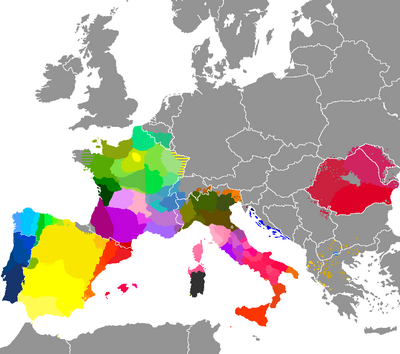Romance languages
The Romance languages are a branch of the Indo-European language family, originally spoken in southern, eastern and western Europe and descended from Vulgar Latin, the language of the Ancient Romans. Today, Romance languages are spoken all over the world, those with the most speakers being Spanish, Portuguese, French, Italian and Romanian. The Romance-speaking territories may be called Romania (not to be confused with the European country of Romania).
These languages - more accurately, the 'standard' dialects of these languages - just happen to be among the most politically important or most widely-spoken Romance varieties in southern Europe and around the world today, and in linguistic terms their dialects form the ends of much smaller 'twigs' in the Romance language family, intermingled with many others. For example, Occitan (or Provençal) is a major language of southern France, Monaco and adjacent parts of Italy and Spain, but is little-known as it lacks political prestige. It may even be mistakenly assumed to be a French dialect, when in fact French and Occitan are very different, with Occitan more closely related to Catalan than it is to French. Similarly, Northern Italian is closer to French than to modern standard Italian; today's political borders are therefore a poor guide to the membership of the Romance language family.
Sardinian is somewhat controversially claimed to be closest to the Latin of the Romans in its structure.[1]
List and classification
The following list of Romance languages is based on books written by recognized scholars, especially Pierre Bec[2], Jacques Allières[3], Rebecca Posner[4], Holtus & Meteltin & Schmitt [5] and M. Metzeltin[6].
- Balkano-Romance group
- Romanian language
- Dalmatian language (extinct)
- Italo-Romance group
- Sardinian language (its classification in the Italo-Romance group is debated)
- Italian language
- Corsican language (its inclusion in Italian is debated)
- Northern Italian language (its inclusion in Italian is debated, some scholars think that it is more related to the Rhaeto-Romance and Gallo-Romance groups)[7]
- Rhaeto-Romance group (an overlap of Gallo-Romance and Italo-Romance)
- Gallo-Romance group
- Occitano-Romance group (an overlap of Gallo-Romance and Ibero-Romance)
- Ibero-Romance group
- Spanish language
- Aragonese language (its inclusion in Spanish is debated)
- Asturian-Leonese language (its inclusion in Spanish is debated)
- Galician-Portuguese language (the split between Galician language and Portuguese language is debated)
- Mozarabic language (extinct)
- Ladino, (Also called Sephardic,originally spoken by jewish people, in moorish Spain, diverged from Spanish the same way the Yiddish language diverged from the German language, then spread across North Africa as Christians oppressed muslims and jews, and drove them out of Christian Spain)
- Ladao (spoken by jewish people, in Portugal, diverged from Portugese the same way the Yiddish language diverged from the German language)
Another classification, especially supported by Gerhard Rohlfs[8], divides the Romance languages between Eastern Romania and Western Romania (Romania being a Latin name for the Romance-speaking world). The dividing line between the two groups splits Italy from La Spezia to Rimini (or more exactly from Carrara to Senigallia), setting Northern Italian in Western Romania and Italian proper in Eastern Romania.
- Eastern Romania comprises Romanian, Dalmatian, Italian proper and Corsican.
- Western Romania comprises Northern Italian, Friulian, Ladin, Romansh, French, Francoprovençal, Occitan, Catalan, Aragonese, Spanish, Asturian-Leonese, Galician-Portuguese and Mozarabic.
- The very conservative Sardinian language remains intermediary between the two groups.
Footnotes
- ↑ Presented in, for example, Bonfante (1999); a short review of this book (O'Donnell, 1999) is available on-line.
- ↑ BEC Pierre (1970-71) (collab. Octave NANDRIS, Žarko MULJAČIĆ), Manuel pratique de philologie romane, Paris: Picard, 2 vol.
- ↑ ALLIÈRES Jacques (2001) Manuel de linguistique romane, coll. Bibliothèque de grammaire et de linguistique, Paris: Honoré Champion
- ↑ POSNER Rebecca (1996) The Romance languages, coll. Cambridge language surveys, Cambridge: Cambridge University Press
- ↑ HOLTUS Günter, & METZELTIN Michael, & SCHMITT Christian (1991) (dir.) Lexikon der Romanistischen Linguistik [LRL], Tübingen: Niemeyer, 8 vol.
- ↑ METZELTIN Miguel (2004) Las lenguas románicas estándar: historia de su formación y de su uso, Oviedo/Uviéu: Academia de la Llingua Asturiana
- ↑ HULL Geoffrey (1982) The linguistic unity of Northern Italy and Rhaetia [PhD thesis], Sydney: University of Sydney, 2 vol.
- ↑ ROHLFS Gerhard (1937) La struttura linguistica dell’Italia, Leipzig
